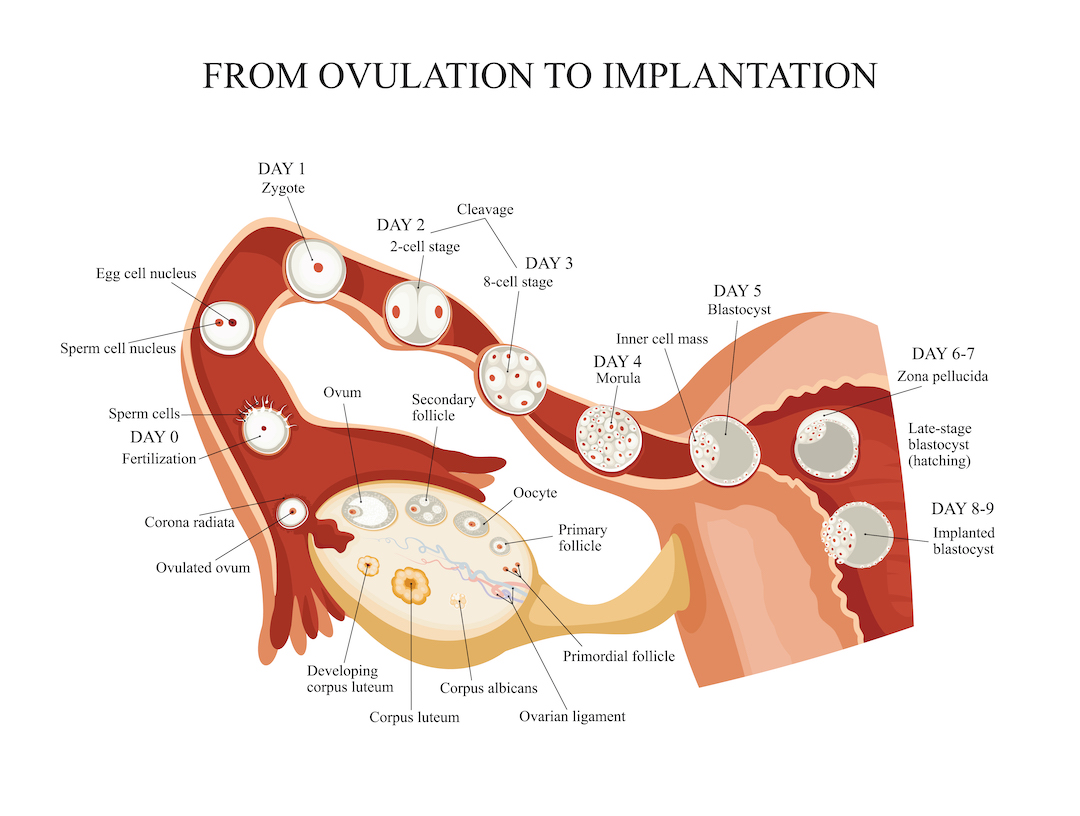Implantation Symptoms, Signs, and Timeline
The most common implantation symptoms, when implantation occurs, how it feels and other early pregnancy questions answered.
By Amylia Ryan and Babylist Staff
If you’re thinking about pregnancy, you’ve probably come across the term implantation in your Googling. You may have heard folks mention implantation cramping or implantation bleeding, but maybe you haven’t felt anything yet. (Not sure if you’re pregnant yet? Check out our guide to the best pregnancy tests so you can know whether to keep an eye out for signs of implantation!)
So what is implantation and when does it take place? Here’s everything you need to know about implantation.
What is implantation?
Though you won’t really know you’re pregnant until you see those two pink lines on a pregnancy test, your body has been hard at work from the moment conception occurred. There’s a lot going on behind the scenes, and it all starts with implantation.
Implantation is the process of the fertilized egg burrowing into the lining of the uterus, which signals to your body that it’s time to build a placenta, develop an embryo and connect it all together with a blood supply.
Although the egg may have been fertilized over a week before, it’s only after implantation that your body starts producing hCG—human chorionic gonadotropin, also known as the hormone that’s picked up by pregnancy tests.
When does implantation occur?
According to Dr. Kimberly Langdon, ob-gyn, implantation usually occurs about five days after fertilization, also known as conception, though every body is different. On average, implantation occurs eight to ten days after ovulation, but it can happen in as early as six days or as late as 12 days.
So an egg embeds itself in your uterus, and about nine months later, you have a baby. Sounds simple, right? Let’s back things up a bit, Biology 101 diagram-style.

Image caption:
Implantation Timeline Day by Day: From Fertilization on Day 0 to Implanted Blastocyst on Day 9.
Your ovary will release an egg into your fallopian tube, and ideally, sperm will be waiting in your fallopian tube. If fertilization is successful (yay!), the egg will begin to divide and travel down your tube toward your uterus. This process usually takes about a week; after that, implantation happens.
But remember, the timing of implantation isn’t an exact science—it could take a little less time or a little more time than the average. For some women, implantation can occur around cycle day 20, while for others, it can be as late as day 26. This is part of why counting your pregnancy weeks can be confusing—you don’t know when the actual start date is! To help figure it all out, you can also use our due date calculator once you’re pretty sure you know when your last period was.
How long does implantation last?
Although most pregnancies are 40 weeks, the process of implantation represents only a fraction of that time. Implantation typically lasts only a few days.
Once it’s complete and the fertilized egg—now called an embryo—is burrowed snugly inside your uterine wall, it will begin to produce hCG. Your body’s progesterone levels will also begin to rise, nourishing your uterine lining and preventing your period from beginning.
What are the four stages of implantation?
The four stages of implantation are migration and hatching, apposition, adhesion and invasion. We get it, that sounds a little bit like scientific jargon and not at all like how you’d describe a developing baby, so let’s break down these terms:
- Migration and hatching are technically two pre-implantation stages that get the whole process kicking off. Migration is the movement of the fertilized egg, or zygote, down the fallopian tube toward the uterus (days one through five in the diagram above). As it’s migrating, the egg is dividing its cells (this is when some identical twins are formed!). But in order for this group of divided cells, or blastocyst, to implant in the uterine lining, it needs to shed its protective coating. Hatching is when the blastocyst releases that protective coating (known as the zona pellucida—like the shell of a chicken egg, but soft and jelly-like) and prepares to start the official implantation stages.
- Apposition is the first stage of contact between the lining of your uterus and the cells of what will eventually be your baby. As the blastocyst enters the uterus, it touches down on the uterine wall and rolls around freely, all while releasing adhesion molecules. Think of it like the blastocyst is wandering around outside your house, knocking on different doors and windows, asking politely where the best place is to come inside.
- Adhesion is exactly what it sounds like: the moment your baby’s tiny group of cells sticks to the uterine lining. This stage is crucial; adhesion failure is one of the causes of pregnancy loss.
- Invasion is, again, exactly what it sounds like. After successfully adhering to the lining of your uterus, the group of cells sinks into the lining and starts to connect to your blood supply. At the end of this stage, implantation has officially been successful!
When to take a pregnancy test
Congratulations are in order, because now you’re officially pregnant! But don’t start peeing on a stick quite yet.
At the very earliest, the most sensitive of pregnancy tests will begin to show a positive result around 10 days past ovulation. Remember—ovulation, fertilization and implantation all work together in a perfect storm to result in a viable pregnancy. Each process has its own timeline, and each timeline differs for every body, so what’s the norm for one pregnant person may be different for another.
Even after an embryo successfully implants and begins producing hCG, it still takes a few days for the hormone to build to a high enough level to be detected by a pregnancy test.
Bottom line: save yourself time and money (not to mention nerves!) and do your best to wait until the first day of your missed period to take a home pregnancy test in order to get an accurate reading.
Can you feel implantation?
According to Dr. Langdon, “implantation can lead to cramping, spotting and abdominal pain,” but that doesn’t mean you’ll definitely feel those symptoms. In fact, some people feel absolutely nothing.
If that’s the case for you, do your best to stay cool, calm and collected during that two-week wait—just because you’re not feeling any implantation symptoms doesn’t mean it’s not happening.
Successful implantation symptoms & early pregnancy signs
According to the Mayo Clinic, the most common symptoms and early signs of implantation may include cramping, spotting, nausea, sore breasts, constipation, bloating, mood swings, headaches and fatigue.
- Implantation cramps. Some people may notice some minor cramping right around the time implantation is taking place. Though there’s no way to know for sure what’s actually going on, what we do know is that this cramping is due to the rise in progesterone that occurs during the second half of your cycle, whether you’re pregnant or not.
- Implantation bleeding. “Implantation bleeding is thought to be light bleeding that occurs about 10 days after ovulation,” says Washington, D.C.-based ob-gyn Dr. Cordelia Nwankwo. This type of bleeding isn’t heavy enough to even fill a panty liner, stops on its own and doesn’t require treatment. It’s experienced by about a third of all pregnant women, though keep in mind that “there are no studies that actually confirm early bleeding as being caused by implantation,” says Nwankwo.
- Nausea. Often some of the first tip-offs that something might be up, nausea and vomiting are popular—and unpleasant—symptoms in early pregnancy. You may also start noticing changes in your appetite or that you’re suddenly getting grossed out by foods you previously loved.
- Tender breasts. As your hormones change, you may start to notice your breasts starting to swell and feeling a lot more sensitive than usual. This also happens to many people before they start their period.
- Constipation and bloating. Things feeling like they’re starting to slow down? You can thank those pregnancy hormones yet again for constipation, a common early pregnancy symptom. You may also notice you’re looking extra bloated during this time, again, due to hormones.
- Fatigue. Growing a baby is hard work! If you’re feeling more tired than usual, that’s often a symptom experienced around the time of implantation, caused by a rise in progesterone and increased blood volume.
- Headaches. Another side effect of your increased blood volume during pregnancy, headaches are a common implantation symptom.
- Mood swings. Notice yourself getting extra bothered by even the smallest of things? Mood swings are a common symptoms during early pregnancy. Blame it on those hormones.
Can you get a positive pregnancy test before implantation?
No, you won’t see a positive pregnancy test before implantation has happened. We get it, you want to find out ASAP, but you’ll only get an answer after implantation, when your body starts producing the hCG that’s detected by the test strips.
While implantation and it’s symptoms can be a bit of a mystery, a positive pregnancy test is the only way to be sure that you’re pregnant. We know it’s hard, but waiting few days until after the day of your missed period to take it will give you a much more accurate result.
Sources:
- University of Michigan Health: How Pregnancy (Conception) Occurs
- Dr. Kim Langdon, OBGYN
- Dr. Robyn Horsager-Boehrer, OBGYN: How early can home pregnancy tests show positive results?
- US Food & Drug Administration (FDA): Pregnancy
- Mayo Clinic: Symptoms of Early Pregnancy: What happens first
- Dr. Cordelia Nwankwo, OBGYN
- Oxford Academic (Oxford University Press): Vaginal bleeding in very early pregnancy
- International Journal of Molecular Science: Physiologic Events of Embryo Implantation and Decidualization in Human and Non-Human Primates
Amylia Ryan
Associate Editor
Amylia Ryan is the Associate Editor at Babylist, specializing in the topics of health, wellness and lifestyle products. Combining a decade of experience in writing and editing with a deep passion for helping people, her number one goal in her work is to ensure new parents feel supported and understood. She herself is a parent to two young children, who are more than willing to help product test endless toys, books, clothes, toiletries and more.
Babylist Staff
Editor
Babylist editors and writers are parents themselves and have years of experience writing and researching, coming from media outlets like Motherly, the SF Chronicle, the New York Times and the Daily Beast, and the fields of early childhood education and publishing. We research and test hundreds of products, survey real Babylist parents and consult reviews in order to recommend the best products and gear for your growing family.


